Contract Law: Comparative Analysis of Negligence and Misrepresentation
VerifiedAdded on 2020/03/28
|11
|2727
|158
Report
AI Summary
This report provides a comprehensive analysis of contract law, specifically focusing on the business torts of negligence and misrepresentation. It defines these torts, outlining the essential elements for establishing them, such as duty of care, breach of duty, and misrepresentation. The report delves into relevant case law, including Donoghue v Stevenson and Caparo Industries plc v Dickman, to illustrate these principles. It also explores negligent misstatement, statutory regulations like the Sale of Goods Act and Australian Consumer Law, and remedies available for both negligence and misrepresentation. Furthermore, the report discusses defenses against these torts, such as voluntary assumption of risk and contributory negligence, offering a thorough understanding of the legal landscape surrounding these crucial business law concepts.
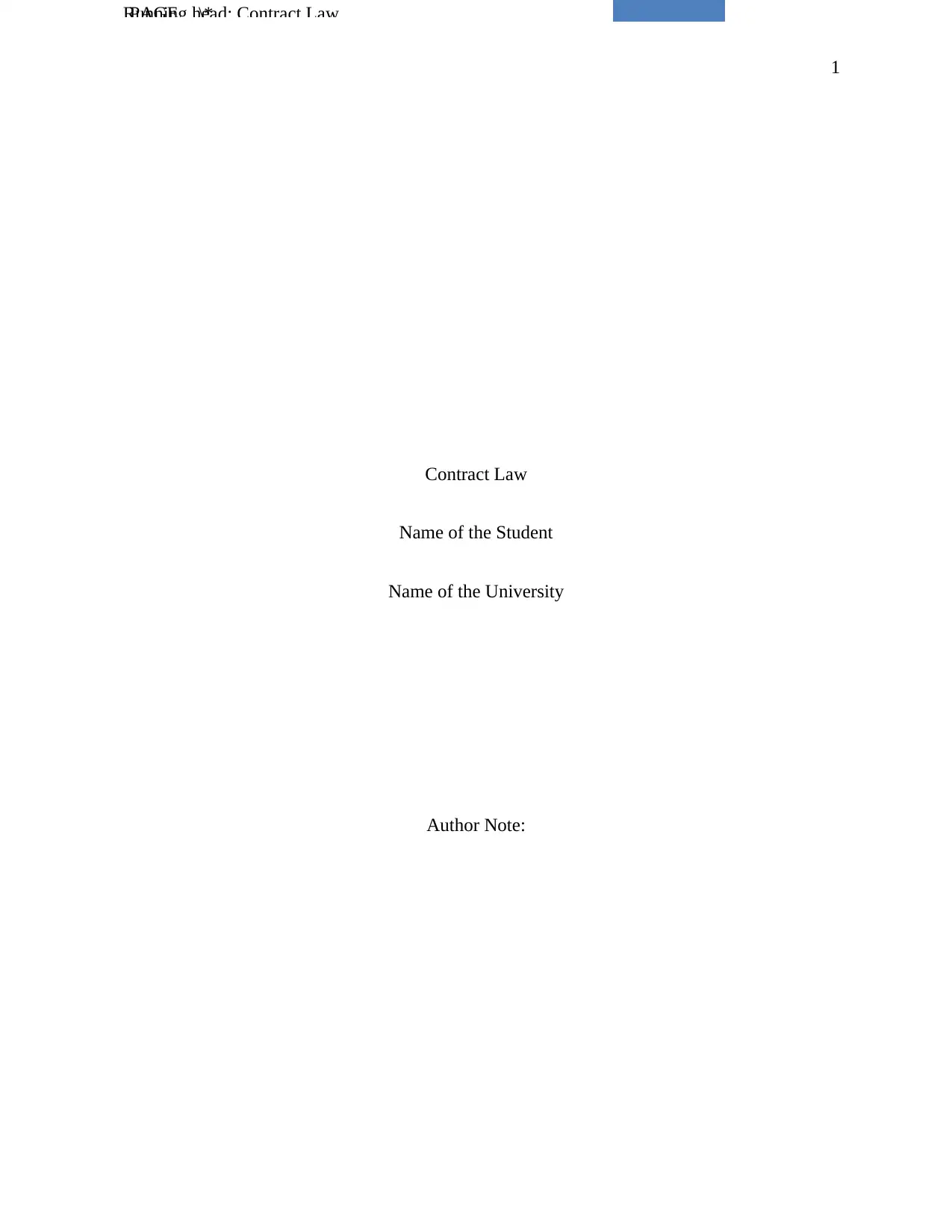
Running head: Contract LawPAGE \*
1
Contract Law
Name of the Student
Name of the University
Author Note:
1
Contract Law
Name of the Student
Name of the University
Author Note:
Paraphrase This Document
Need a fresh take? Get an instant paraphrase of this document with our AI Paraphraser
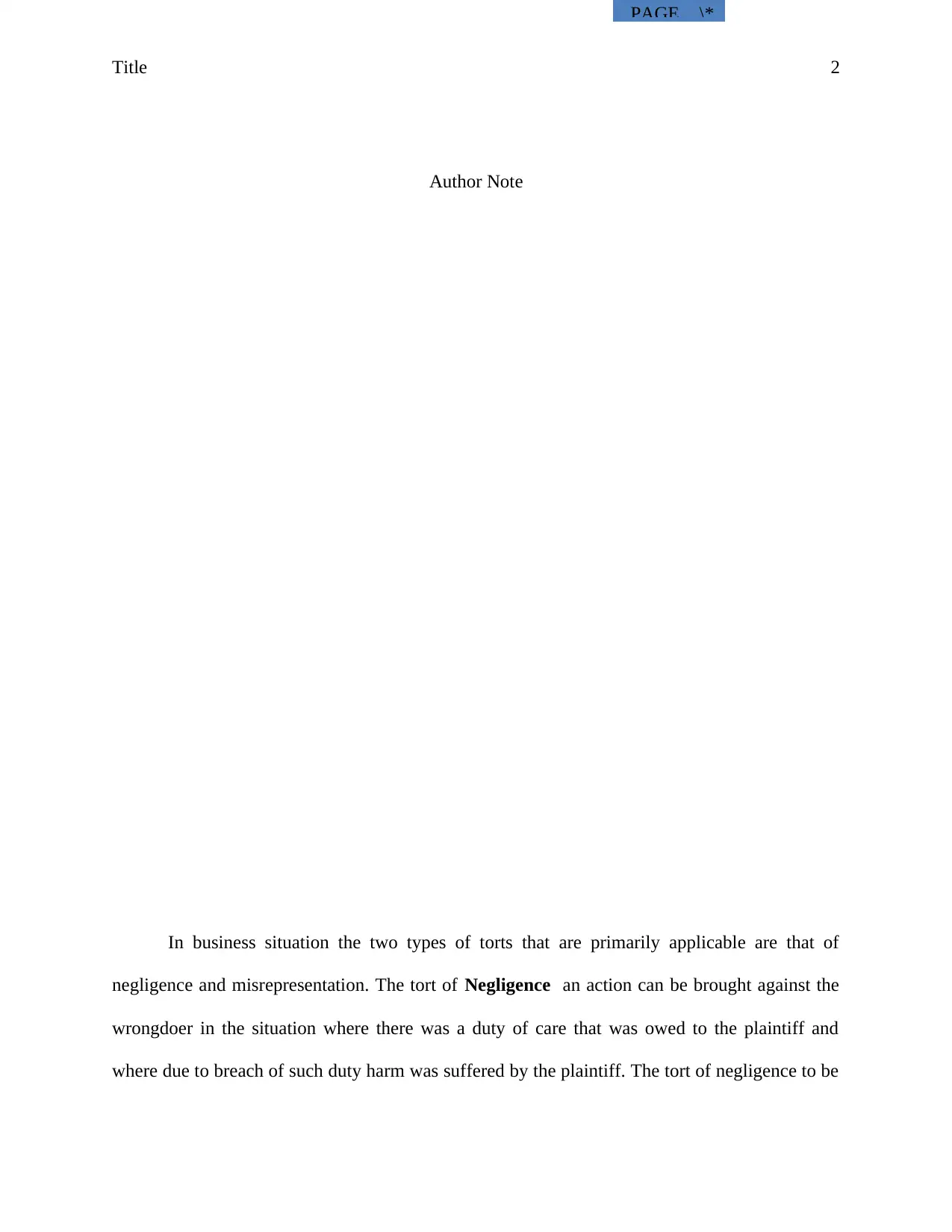
PAGE \*
Title 2
Author Note
In business situation the two types of torts that are primarily applicable are that of
negligence and misrepresentation. The tort of Negligence an action can be brought against the
wrongdoer in the situation where there was a duty of care that was owed to the plaintiff and
where due to breach of such duty harm was suffered by the plaintiff. The tort of negligence to be
Title 2
Author Note
In business situation the two types of torts that are primarily applicable are that of
negligence and misrepresentation. The tort of Negligence an action can be brought against the
wrongdoer in the situation where there was a duty of care that was owed to the plaintiff and
where due to breach of such duty harm was suffered by the plaintiff. The tort of negligence to be
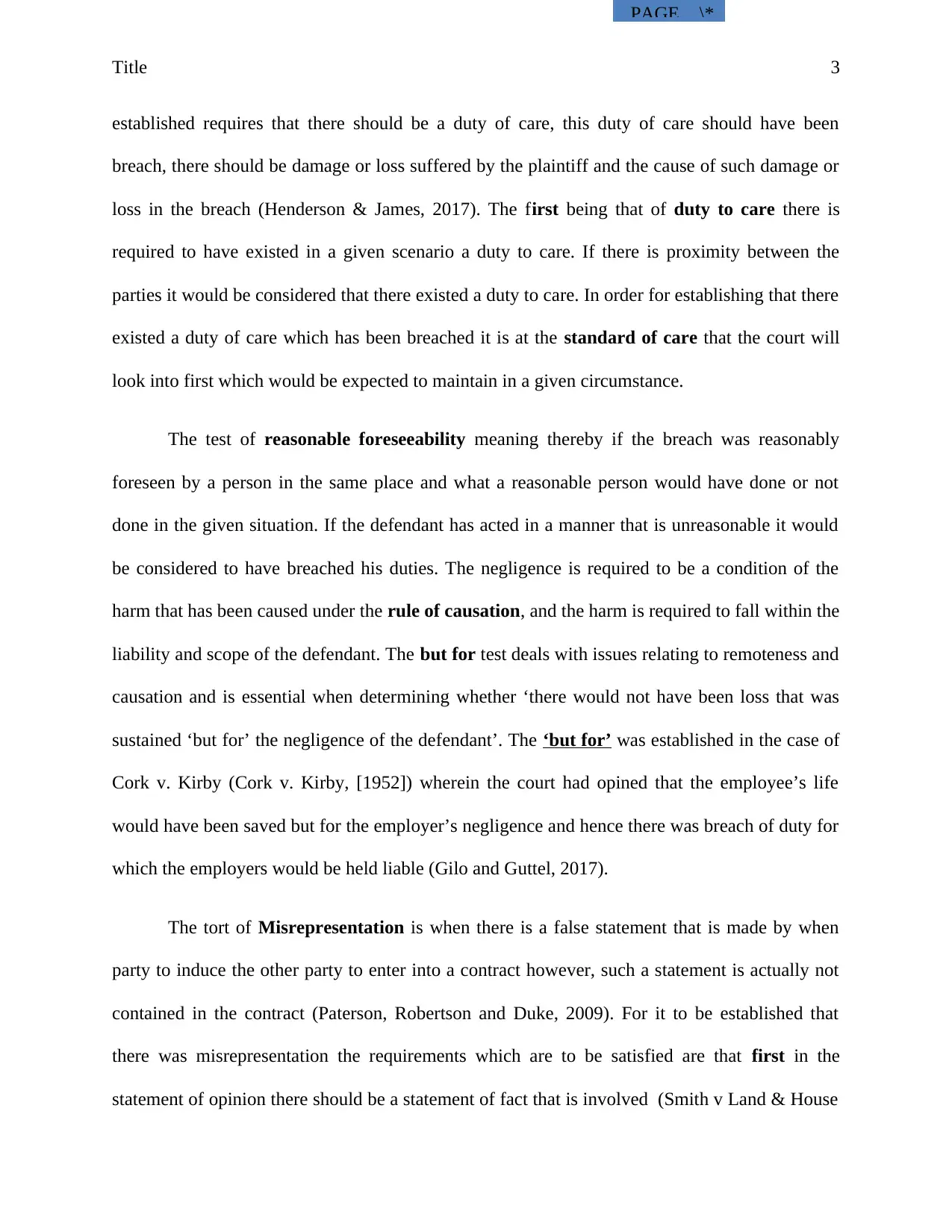
PAGE \*
Title 3
established requires that there should be a duty of care, this duty of care should have been
breach, there should be damage or loss suffered by the plaintiff and the cause of such damage or
loss in the breach (Henderson & James, 2017). The first being that of duty to care there is
required to have existed in a given scenario a duty to care. If there is proximity between the
parties it would be considered that there existed a duty to care. In order for establishing that there
existed a duty of care which has been breached it is at the standard of care that the court will
look into first which would be expected to maintain in a given circumstance.
The test of reasonable foreseeability meaning thereby if the breach was reasonably
foreseen by a person in the same place and what a reasonable person would have done or not
done in the given situation. If the defendant has acted in a manner that is unreasonable it would
be considered to have breached his duties. The negligence is required to be a condition of the
harm that has been caused under the rule of causation, and the harm is required to fall within the
liability and scope of the defendant. The but for test deals with issues relating to remoteness and
causation and is essential when determining whether ‘there would not have been loss that was
sustained ‘but for’ the negligence of the defendant’. The ‘but for’ was established in the case of
Cork v. Kirby (Cork v. Kirby, [1952]) wherein the court had opined that the employee’s life
would have been saved but for the employer’s negligence and hence there was breach of duty for
which the employers would be held liable (Gilo and Guttel, 2017).
The tort of Misrepresentation is when there is a false statement that is made by when
party to induce the other party to enter into a contract however, such a statement is actually not
contained in the contract (Paterson, Robertson and Duke, 2009). For it to be established that
there was misrepresentation the requirements which are to be satisfied are that first in the
statement of opinion there should be a statement of fact that is involved (Smith v Land & House
Title 3
established requires that there should be a duty of care, this duty of care should have been
breach, there should be damage or loss suffered by the plaintiff and the cause of such damage or
loss in the breach (Henderson & James, 2017). The first being that of duty to care there is
required to have existed in a given scenario a duty to care. If there is proximity between the
parties it would be considered that there existed a duty to care. In order for establishing that there
existed a duty of care which has been breached it is at the standard of care that the court will
look into first which would be expected to maintain in a given circumstance.
The test of reasonable foreseeability meaning thereby if the breach was reasonably
foreseen by a person in the same place and what a reasonable person would have done or not
done in the given situation. If the defendant has acted in a manner that is unreasonable it would
be considered to have breached his duties. The negligence is required to be a condition of the
harm that has been caused under the rule of causation, and the harm is required to fall within the
liability and scope of the defendant. The but for test deals with issues relating to remoteness and
causation and is essential when determining whether ‘there would not have been loss that was
sustained ‘but for’ the negligence of the defendant’. The ‘but for’ was established in the case of
Cork v. Kirby (Cork v. Kirby, [1952]) wherein the court had opined that the employee’s life
would have been saved but for the employer’s negligence and hence there was breach of duty for
which the employers would be held liable (Gilo and Guttel, 2017).
The tort of Misrepresentation is when there is a false statement that is made by when
party to induce the other party to enter into a contract however, such a statement is actually not
contained in the contract (Paterson, Robertson and Duke, 2009). For it to be established that
there was misrepresentation the requirements which are to be satisfied are that first in the
statement of opinion there should be a statement of fact that is involved (Smith v Land & House
⊘ This is a preview!⊘
Do you want full access?
Subscribe today to unlock all pages.

Trusted by 1+ million students worldwide
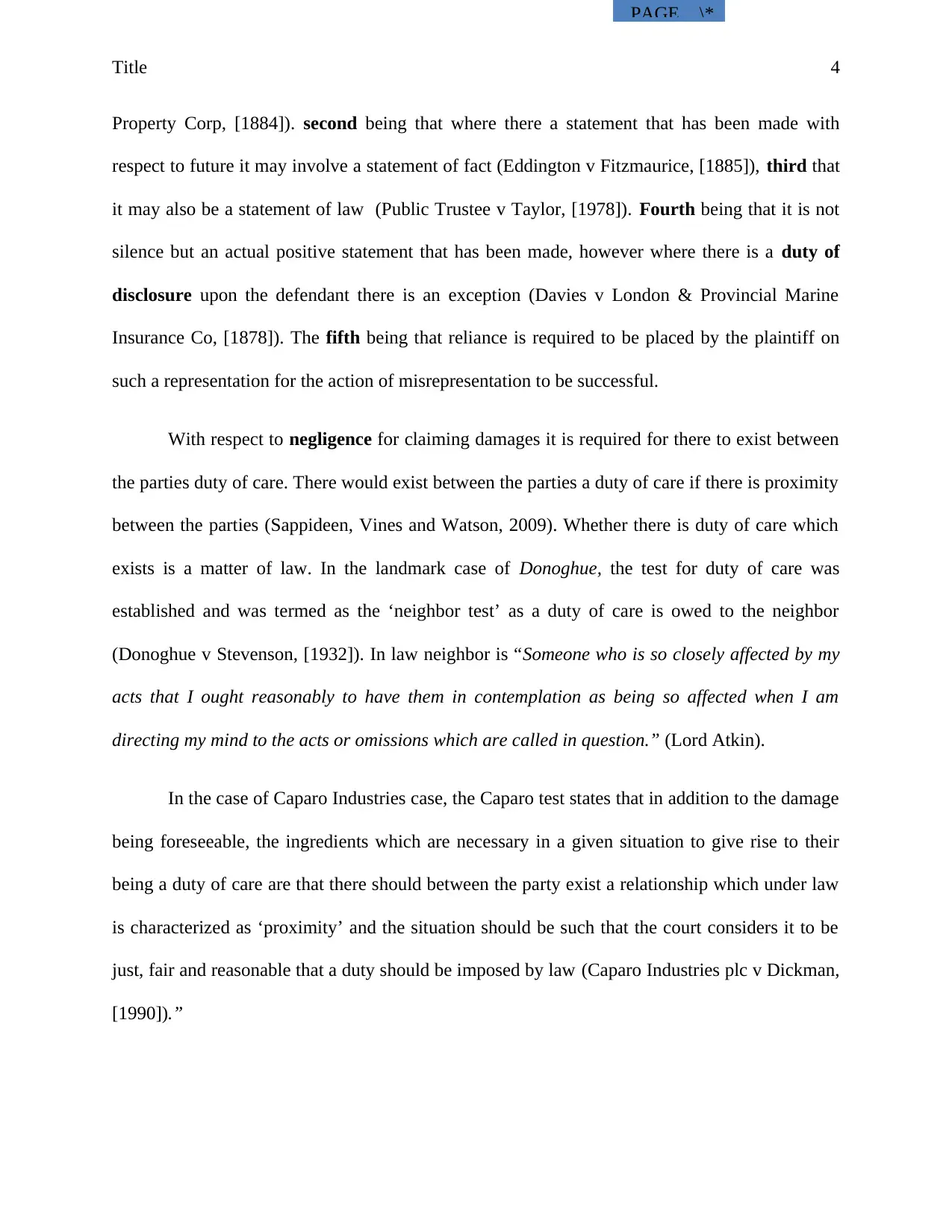
PAGE \*
Title 4
Property Corp, [1884]). second being that where there a statement that has been made with
respect to future it may involve a statement of fact (Eddington v Fitzmaurice, [1885]), third that
it may also be a statement of law (Public Trustee v Taylor, [1978]). Fourth being that it is not
silence but an actual positive statement that has been made, however where there is a duty of
disclosure upon the defendant there is an exception (Davies v London & Provincial Marine
Insurance Co, [1878]). The fifth being that reliance is required to be placed by the plaintiff on
such a representation for the action of misrepresentation to be successful.
With respect to negligence for claiming damages it is required for there to exist between
the parties duty of care. There would exist between the parties a duty of care if there is proximity
between the parties (Sappideen, Vines and Watson, 2009). Whether there is duty of care which
exists is a matter of law. In the landmark case of Donoghue, the test for duty of care was
established and was termed as the ‘neighbor test’ as a duty of care is owed to the neighbor
(Donoghue v Stevenson, [1932]). In law neighbor is “Someone who is so closely affected by my
acts that I ought reasonably to have them in contemplation as being so affected when I am
directing my mind to the acts or omissions which are called in question.” (Lord Atkin).
In the case of Caparo Industries case, the Caparo test states that in addition to the damage
being foreseeable, the ingredients which are necessary in a given situation to give rise to their
being a duty of care are that there should between the party exist a relationship which under law
is characterized as ‘proximity’ and the situation should be such that the court considers it to be
just, fair and reasonable that a duty should be imposed by law (Caparo Industries plc v Dickman,
[1990]).”
Title 4
Property Corp, [1884]). second being that where there a statement that has been made with
respect to future it may involve a statement of fact (Eddington v Fitzmaurice, [1885]), third that
it may also be a statement of law (Public Trustee v Taylor, [1978]). Fourth being that it is not
silence but an actual positive statement that has been made, however where there is a duty of
disclosure upon the defendant there is an exception (Davies v London & Provincial Marine
Insurance Co, [1878]). The fifth being that reliance is required to be placed by the plaintiff on
such a representation for the action of misrepresentation to be successful.
With respect to negligence for claiming damages it is required for there to exist between
the parties duty of care. There would exist between the parties a duty of care if there is proximity
between the parties (Sappideen, Vines and Watson, 2009). Whether there is duty of care which
exists is a matter of law. In the landmark case of Donoghue, the test for duty of care was
established and was termed as the ‘neighbor test’ as a duty of care is owed to the neighbor
(Donoghue v Stevenson, [1932]). In law neighbor is “Someone who is so closely affected by my
acts that I ought reasonably to have them in contemplation as being so affected when I am
directing my mind to the acts or omissions which are called in question.” (Lord Atkin).
In the case of Caparo Industries case, the Caparo test states that in addition to the damage
being foreseeable, the ingredients which are necessary in a given situation to give rise to their
being a duty of care are that there should between the party exist a relationship which under law
is characterized as ‘proximity’ and the situation should be such that the court considers it to be
just, fair and reasonable that a duty should be imposed by law (Caparo Industries plc v Dickman,
[1990]).”
Paraphrase This Document
Need a fresh take? Get an instant paraphrase of this document with our AI Paraphraser
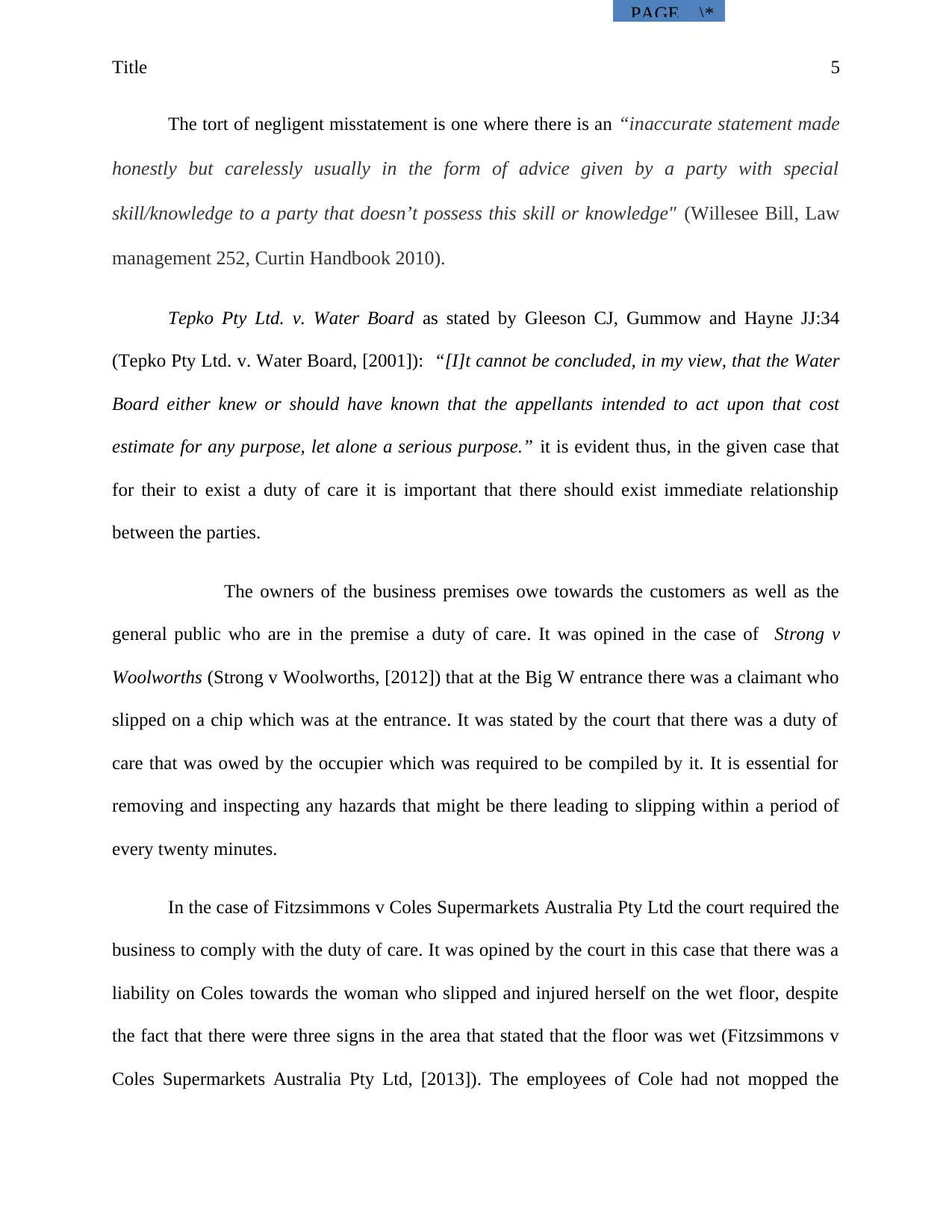
PAGE \*
Title 5
The tort of negligent misstatement is one where there is an “inaccurate statement made
honestly but carelessly usually in the form of advice given by a party with special
skill/knowledge to a party that doesn’t possess this skill or knowledge" (Willesee Bill, Law
management 252, Curtin Handbook 2010).
Tepko Pty Ltd. v. Water Board as stated by Gleeson CJ, Gummow and Hayne JJ:34
(Tepko Pty Ltd. v. Water Board, [2001]): “[I]t cannot be concluded, in my view, that the Water
Board either knew or should have known that the appellants intended to act upon that cost
estimate for any purpose, let alone a serious purpose.” it is evident thus, in the given case that
for their to exist a duty of care it is important that there should exist immediate relationship
between the parties.
The owners of the business premises owe towards the customers as well as the
general public who are in the premise a duty of care. It was opined in the case of Strong v
Woolworths (Strong v Woolworths, [2012]) that at the Big W entrance there was a claimant who
slipped on a chip which was at the entrance. It was stated by the court that there was a duty of
care that was owed by the occupier which was required to be compiled by it. It is essential for
removing and inspecting any hazards that might be there leading to slipping within a period of
every twenty minutes.
In the case of Fitzsimmons v Coles Supermarkets Australia Pty Ltd the court required the
business to comply with the duty of care. It was opined by the court in this case that there was a
liability on Coles towards the woman who slipped and injured herself on the wet floor, despite
the fact that there were three signs in the area that stated that the floor was wet (Fitzsimmons v
Coles Supermarkets Australia Pty Ltd, [2013]). The employees of Cole had not mopped the
Title 5
The tort of negligent misstatement is one where there is an “inaccurate statement made
honestly but carelessly usually in the form of advice given by a party with special
skill/knowledge to a party that doesn’t possess this skill or knowledge" (Willesee Bill, Law
management 252, Curtin Handbook 2010).
Tepko Pty Ltd. v. Water Board as stated by Gleeson CJ, Gummow and Hayne JJ:34
(Tepko Pty Ltd. v. Water Board, [2001]): “[I]t cannot be concluded, in my view, that the Water
Board either knew or should have known that the appellants intended to act upon that cost
estimate for any purpose, let alone a serious purpose.” it is evident thus, in the given case that
for their to exist a duty of care it is important that there should exist immediate relationship
between the parties.
The owners of the business premises owe towards the customers as well as the
general public who are in the premise a duty of care. It was opined in the case of Strong v
Woolworths (Strong v Woolworths, [2012]) that at the Big W entrance there was a claimant who
slipped on a chip which was at the entrance. It was stated by the court that there was a duty of
care that was owed by the occupier which was required to be compiled by it. It is essential for
removing and inspecting any hazards that might be there leading to slipping within a period of
every twenty minutes.
In the case of Fitzsimmons v Coles Supermarkets Australia Pty Ltd the court required the
business to comply with the duty of care. It was opined by the court in this case that there was a
liability on Coles towards the woman who slipped and injured herself on the wet floor, despite
the fact that there were three signs in the area that stated that the floor was wet (Fitzsimmons v
Coles Supermarkets Australia Pty Ltd, [2013]). The employees of Cole had not mopped the
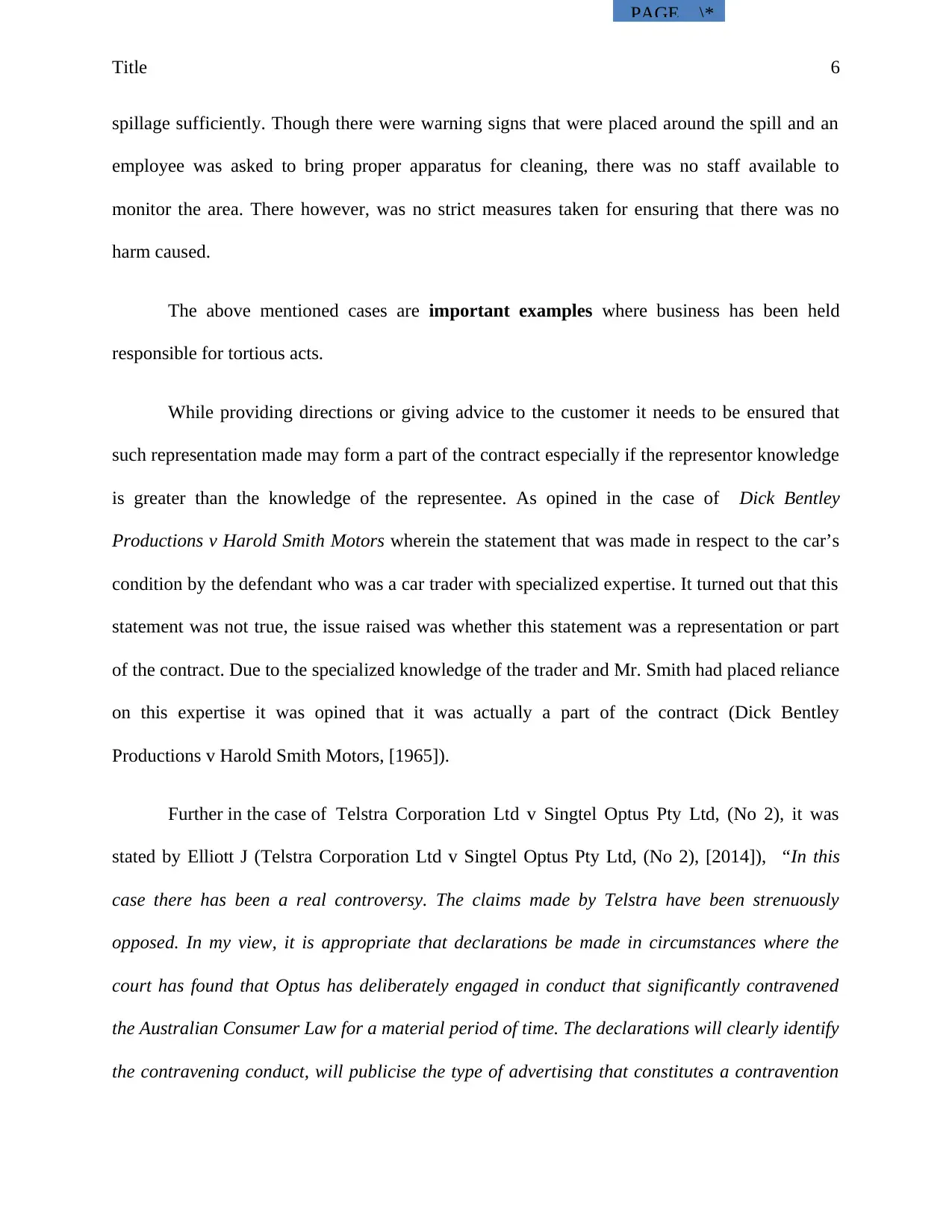
PAGE \*
Title 6
spillage sufficiently. Though there were warning signs that were placed around the spill and an
employee was asked to bring proper apparatus for cleaning, there was no staff available to
monitor the area. There however, was no strict measures taken for ensuring that there was no
harm caused.
The above mentioned cases are important examples where business has been held
responsible for tortious acts.
While providing directions or giving advice to the customer it needs to be ensured that
such representation made may form a part of the contract especially if the representor knowledge
is greater than the knowledge of the representee. As opined in the case of Dick Bentley
Productions v Harold Smith Motors wherein the statement that was made in respect to the car’s
condition by the defendant who was a car trader with specialized expertise. It turned out that this
statement was not true, the issue raised was whether this statement was a representation or part
of the contract. Due to the specialized knowledge of the trader and Mr. Smith had placed reliance
on this expertise it was opined that it was actually a part of the contract (Dick Bentley
Productions v Harold Smith Motors, [1965]).
Further in the case of Telstra Corporation Ltd v Singtel Optus Pty Ltd, (No 2), it was
stated by Elliott J (Telstra Corporation Ltd v Singtel Optus Pty Ltd, (No 2), [2014]), “In this
case there has been a real controversy. The claims made by Telstra have been strenuously
opposed. In my view, it is appropriate that declarations be made in circumstances where the
court has found that Optus has deliberately engaged in conduct that significantly contravened
the Australian Consumer Law for a material period of time. The declarations will clearly identify
the contravening conduct, will publicise the type of advertising that constitutes a contravention
Title 6
spillage sufficiently. Though there were warning signs that were placed around the spill and an
employee was asked to bring proper apparatus for cleaning, there was no staff available to
monitor the area. There however, was no strict measures taken for ensuring that there was no
harm caused.
The above mentioned cases are important examples where business has been held
responsible for tortious acts.
While providing directions or giving advice to the customer it needs to be ensured that
such representation made may form a part of the contract especially if the representor knowledge
is greater than the knowledge of the representee. As opined in the case of Dick Bentley
Productions v Harold Smith Motors wherein the statement that was made in respect to the car’s
condition by the defendant who was a car trader with specialized expertise. It turned out that this
statement was not true, the issue raised was whether this statement was a representation or part
of the contract. Due to the specialized knowledge of the trader and Mr. Smith had placed reliance
on this expertise it was opined that it was actually a part of the contract (Dick Bentley
Productions v Harold Smith Motors, [1965]).
Further in the case of Telstra Corporation Ltd v Singtel Optus Pty Ltd, (No 2), it was
stated by Elliott J (Telstra Corporation Ltd v Singtel Optus Pty Ltd, (No 2), [2014]), “In this
case there has been a real controversy. The claims made by Telstra have been strenuously
opposed. In my view, it is appropriate that declarations be made in circumstances where the
court has found that Optus has deliberately engaged in conduct that significantly contravened
the Australian Consumer Law for a material period of time. The declarations will clearly identify
the contravening conduct, will publicise the type of advertising that constitutes a contravention
⊘ This is a preview!⊘
Do you want full access?
Subscribe today to unlock all pages.

Trusted by 1+ million students worldwide
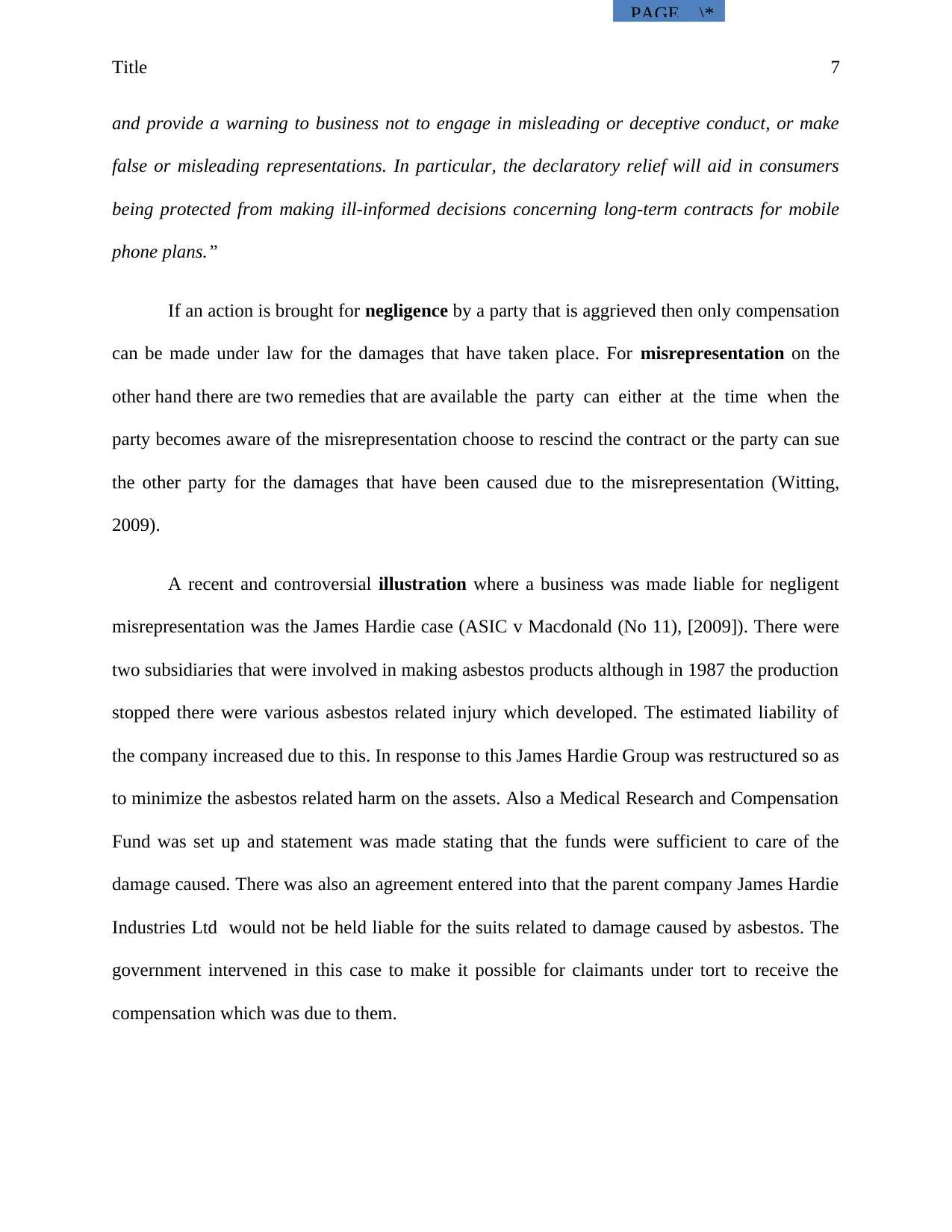
PAGE \*
Title 7
and provide a warning to business not to engage in misleading or deceptive conduct, or make
false or misleading representations. In particular, the declaratory relief will aid in consumers
being protected from making ill-informed decisions concerning long-term contracts for mobile
phone plans.”
If an action is brought for negligence by a party that is aggrieved then only compensation
can be made under law for the damages that have taken place. For misrepresentation on the
other hand there are two remedies that are available the party can either at the time when the
party becomes aware of the misrepresentation choose to rescind the contract or the party can sue
the other party for the damages that have been caused due to the misrepresentation (Witting,
2009).
A recent and controversial illustration where a business was made liable for negligent
misrepresentation was the James Hardie case (ASIC v Macdonald (No 11), [2009]). There were
two subsidiaries that were involved in making asbestos products although in 1987 the production
stopped there were various asbestos related injury which developed. The estimated liability of
the company increased due to this. In response to this James Hardie Group was restructured so as
to minimize the asbestos related harm on the assets. Also a Medical Research and Compensation
Fund was set up and statement was made stating that the funds were sufficient to care of the
damage caused. There was also an agreement entered into that the parent company James Hardie
Industries Ltd would not be held liable for the suits related to damage caused by asbestos. The
government intervened in this case to make it possible for claimants under tort to receive the
compensation which was due to them.
Title 7
and provide a warning to business not to engage in misleading or deceptive conduct, or make
false or misleading representations. In particular, the declaratory relief will aid in consumers
being protected from making ill-informed decisions concerning long-term contracts for mobile
phone plans.”
If an action is brought for negligence by a party that is aggrieved then only compensation
can be made under law for the damages that have taken place. For misrepresentation on the
other hand there are two remedies that are available the party can either at the time when the
party becomes aware of the misrepresentation choose to rescind the contract or the party can sue
the other party for the damages that have been caused due to the misrepresentation (Witting,
2009).
A recent and controversial illustration where a business was made liable for negligent
misrepresentation was the James Hardie case (ASIC v Macdonald (No 11), [2009]). There were
two subsidiaries that were involved in making asbestos products although in 1987 the production
stopped there were various asbestos related injury which developed. The estimated liability of
the company increased due to this. In response to this James Hardie Group was restructured so as
to minimize the asbestos related harm on the assets. Also a Medical Research and Compensation
Fund was set up and statement was made stating that the funds were sufficient to care of the
damage caused. There was also an agreement entered into that the parent company James Hardie
Industries Ltd would not be held liable for the suits related to damage caused by asbestos. The
government intervened in this case to make it possible for claimants under tort to receive the
compensation which was due to them.
Paraphrase This Document
Need a fresh take? Get an instant paraphrase of this document with our AI Paraphraser
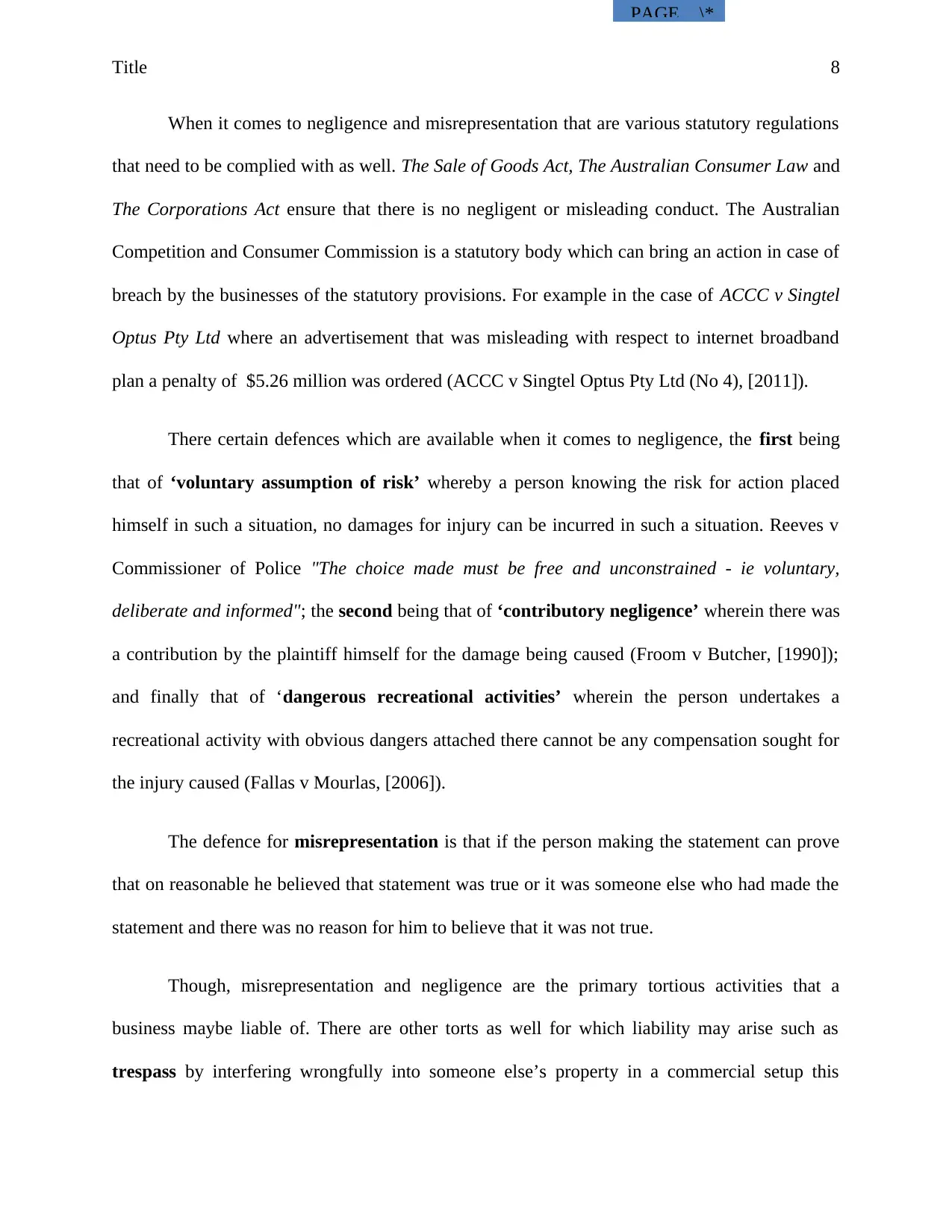
PAGE \*
Title 8
When it comes to negligence and misrepresentation that are various statutory regulations
that need to be complied with as well. The Sale of Goods Act, The Australian Consumer Law and
The Corporations Act ensure that there is no negligent or misleading conduct. The Australian
Competition and Consumer Commission is a statutory body which can bring an action in case of
breach by the businesses of the statutory provisions. For example in the case of ACCC v Singtel
Optus Pty Ltd where an advertisement that was misleading with respect to internet broadband
plan a penalty of $5.26 million was ordered (ACCC v Singtel Optus Pty Ltd (No 4), [2011]).
There certain defences which are available when it comes to negligence, the first being
that of ‘voluntary assumption of risk’ whereby a person knowing the risk for action placed
himself in such a situation, no damages for injury can be incurred in such a situation. Reeves v
Commissioner of Police "The choice made must be free and unconstrained - ie voluntary,
deliberate and informed"; the second being that of ‘contributory negligence’ wherein there was
a contribution by the plaintiff himself for the damage being caused (Froom v Butcher, [1990]);
and finally that of ‘dangerous recreational activities’ wherein the person undertakes a
recreational activity with obvious dangers attached there cannot be any compensation sought for
the injury caused (Fallas v Mourlas, [2006]).
The defence for misrepresentation is that if the person making the statement can prove
that on reasonable he believed that statement was true or it was someone else who had made the
statement and there was no reason for him to believe that it was not true.
Though, misrepresentation and negligence are the primary tortious activities that a
business maybe liable of. There are other torts as well for which liability may arise such as
trespass by interfering wrongfully into someone else’s property in a commercial setup this
Title 8
When it comes to negligence and misrepresentation that are various statutory regulations
that need to be complied with as well. The Sale of Goods Act, The Australian Consumer Law and
The Corporations Act ensure that there is no negligent or misleading conduct. The Australian
Competition and Consumer Commission is a statutory body which can bring an action in case of
breach by the businesses of the statutory provisions. For example in the case of ACCC v Singtel
Optus Pty Ltd where an advertisement that was misleading with respect to internet broadband
plan a penalty of $5.26 million was ordered (ACCC v Singtel Optus Pty Ltd (No 4), [2011]).
There certain defences which are available when it comes to negligence, the first being
that of ‘voluntary assumption of risk’ whereby a person knowing the risk for action placed
himself in such a situation, no damages for injury can be incurred in such a situation. Reeves v
Commissioner of Police "The choice made must be free and unconstrained - ie voluntary,
deliberate and informed"; the second being that of ‘contributory negligence’ wherein there was
a contribution by the plaintiff himself for the damage being caused (Froom v Butcher, [1990]);
and finally that of ‘dangerous recreational activities’ wherein the person undertakes a
recreational activity with obvious dangers attached there cannot be any compensation sought for
the injury caused (Fallas v Mourlas, [2006]).
The defence for misrepresentation is that if the person making the statement can prove
that on reasonable he believed that statement was true or it was someone else who had made the
statement and there was no reason for him to believe that it was not true.
Though, misrepresentation and negligence are the primary tortious activities that a
business maybe liable of. There are other torts as well for which liability may arise such as
trespass by interfering wrongfully into someone else’s property in a commercial setup this
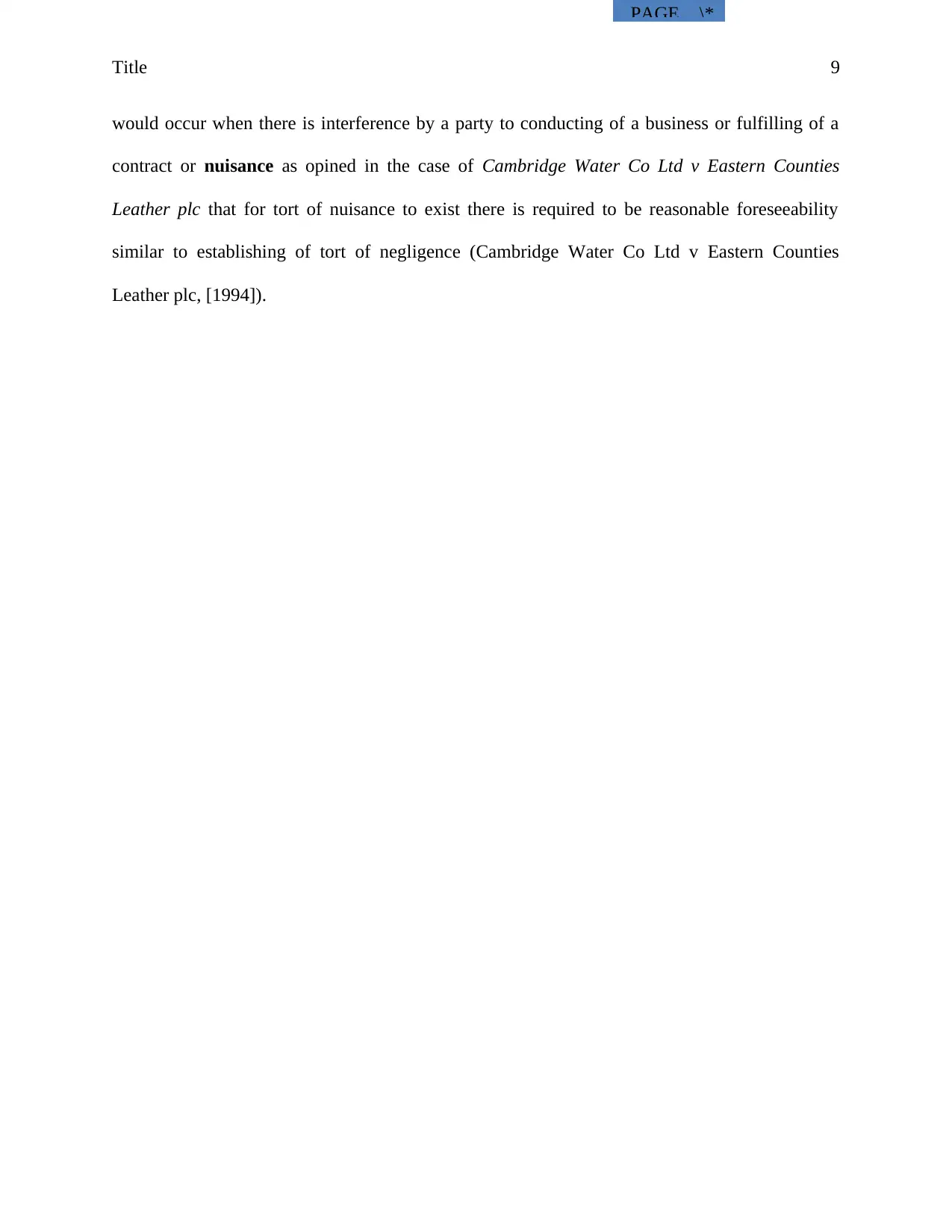
PAGE \*
Title 9
would occur when there is interference by a party to conducting of a business or fulfilling of a
contract or nuisance as opined in the case of Cambridge Water Co Ltd v Eastern Counties
Leather plc that for tort of nuisance to exist there is required to be reasonable foreseeability
similar to establishing of tort of negligence (Cambridge Water Co Ltd v Eastern Counties
Leather plc, [1994]).
Title 9
would occur when there is interference by a party to conducting of a business or fulfilling of a
contract or nuisance as opined in the case of Cambridge Water Co Ltd v Eastern Counties
Leather plc that for tort of nuisance to exist there is required to be reasonable foreseeability
similar to establishing of tort of negligence (Cambridge Water Co Ltd v Eastern Counties
Leather plc, [1994]).
⊘ This is a preview!⊘
Do you want full access?
Subscribe today to unlock all pages.

Trusted by 1+ million students worldwide
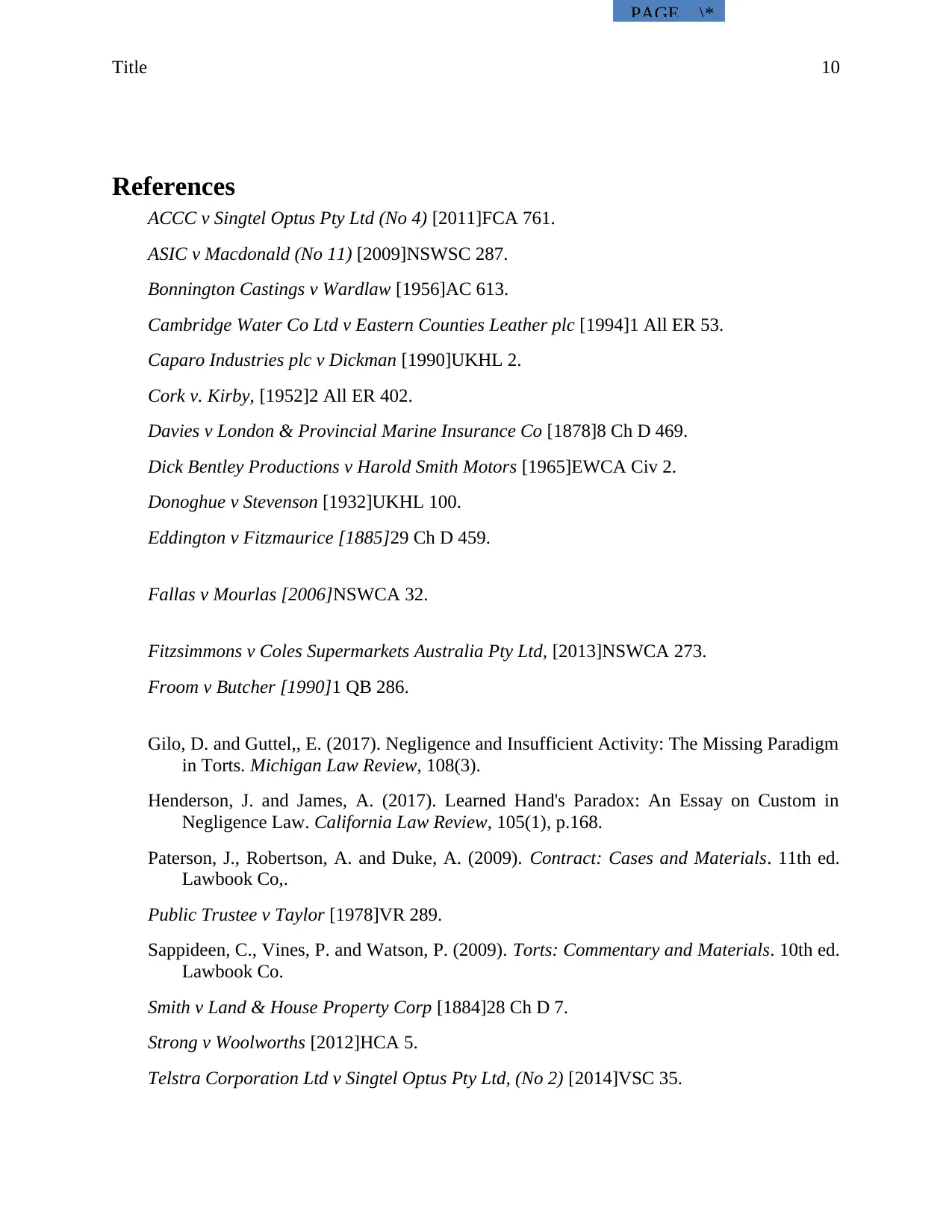
PAGE \*
Title 10
References
ACCC v Singtel Optus Pty Ltd (No 4) [2011]FCA 761.
ASIC v Macdonald (No 11) [2009]NSWSC 287.
Bonnington Castings v Wardlaw [1956]AC 613.
Cambridge Water Co Ltd v Eastern Counties Leather plc [1994]1 All ER 53.
Caparo Industries plc v Dickman [1990]UKHL 2.
Cork v. Kirby, [1952]2 All ER 402.
Davies v London & Provincial Marine Insurance Co [1878]8 Ch D 469.
Dick Bentley Productions v Harold Smith Motors [1965]EWCA Civ 2.
Donoghue v Stevenson [1932]UKHL 100.
Eddington v Fitzmaurice [1885]29 Ch D 459.
Fallas v Mourlas [2006]NSWCA 32.
Fitzsimmons v Coles Supermarkets Australia Pty Ltd, [2013]NSWCA 273.
Froom v Butcher [1990]1 QB 286.
Gilo, D. and Guttel,, E. (2017). Negligence and Insufficient Activity: The Missing Paradigm
in Torts. Michigan Law Review, 108(3).
Henderson, J. and James, A. (2017). Learned Hand's Paradox: An Essay on Custom in
Negligence Law. California Law Review, 105(1), p.168.
Paterson, J., Robertson, A. and Duke, A. (2009). Contract: Cases and Materials. 11th ed.
Lawbook Co,.
Public Trustee v Taylor [1978]VR 289.
Sappideen, C., Vines, P. and Watson, P. (2009). Torts: Commentary and Materials. 10th ed.
Lawbook Co.
Smith v Land & House Property Corp [1884]28 Ch D 7.
Strong v Woolworths [2012]HCA 5.
Telstra Corporation Ltd v Singtel Optus Pty Ltd, (No 2) [2014]VSC 35.
Title 10
References
ACCC v Singtel Optus Pty Ltd (No 4) [2011]FCA 761.
ASIC v Macdonald (No 11) [2009]NSWSC 287.
Bonnington Castings v Wardlaw [1956]AC 613.
Cambridge Water Co Ltd v Eastern Counties Leather plc [1994]1 All ER 53.
Caparo Industries plc v Dickman [1990]UKHL 2.
Cork v. Kirby, [1952]2 All ER 402.
Davies v London & Provincial Marine Insurance Co [1878]8 Ch D 469.
Dick Bentley Productions v Harold Smith Motors [1965]EWCA Civ 2.
Donoghue v Stevenson [1932]UKHL 100.
Eddington v Fitzmaurice [1885]29 Ch D 459.
Fallas v Mourlas [2006]NSWCA 32.
Fitzsimmons v Coles Supermarkets Australia Pty Ltd, [2013]NSWCA 273.
Froom v Butcher [1990]1 QB 286.
Gilo, D. and Guttel,, E. (2017). Negligence and Insufficient Activity: The Missing Paradigm
in Torts. Michigan Law Review, 108(3).
Henderson, J. and James, A. (2017). Learned Hand's Paradox: An Essay on Custom in
Negligence Law. California Law Review, 105(1), p.168.
Paterson, J., Robertson, A. and Duke, A. (2009). Contract: Cases and Materials. 11th ed.
Lawbook Co,.
Public Trustee v Taylor [1978]VR 289.
Sappideen, C., Vines, P. and Watson, P. (2009). Torts: Commentary and Materials. 10th ed.
Lawbook Co.
Smith v Land & House Property Corp [1884]28 Ch D 7.
Strong v Woolworths [2012]HCA 5.
Telstra Corporation Ltd v Singtel Optus Pty Ltd, (No 2) [2014]VSC 35.
Paraphrase This Document
Need a fresh take? Get an instant paraphrase of this document with our AI Paraphraser
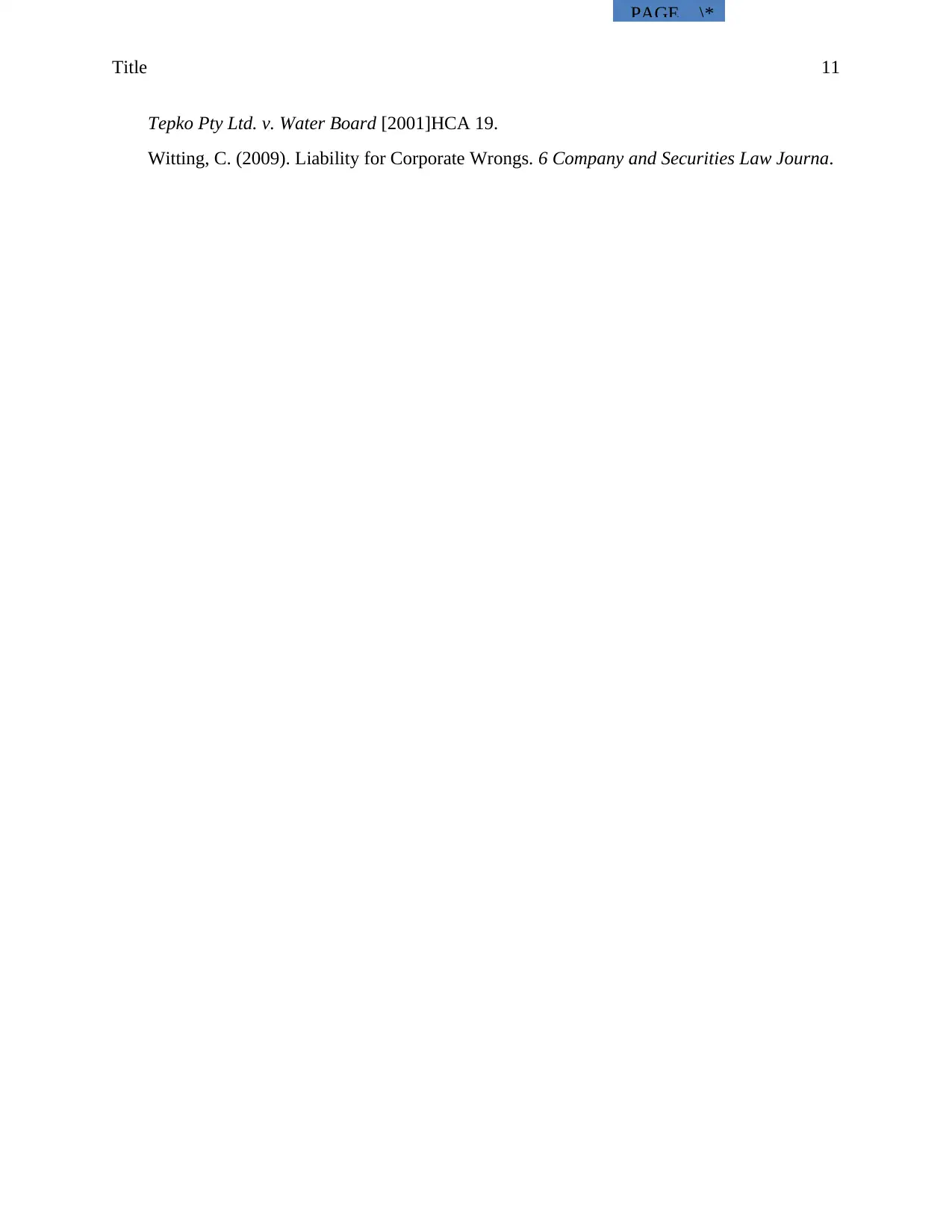
PAGE \*
Title 11
Tepko Pty Ltd. v. Water Board [2001]HCA 19.
Witting, C. (2009). Liability for Corporate Wrongs. 6 Company and Securities Law Journa.
Title 11
Tepko Pty Ltd. v. Water Board [2001]HCA 19.
Witting, C. (2009). Liability for Corporate Wrongs. 6 Company and Securities Law Journa.
1 out of 11
Related Documents
Your All-in-One AI-Powered Toolkit for Academic Success.
+13062052269
info@desklib.com
Available 24*7 on WhatsApp / Email
![[object Object]](/_next/static/media/star-bottom.7253800d.svg)
Unlock your academic potential
Copyright © 2020–2025 A2Z Services. All Rights Reserved. Developed and managed by ZUCOL.





